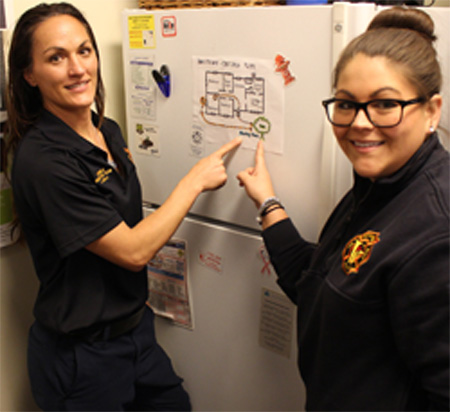Accidents happen, but many times accidents can be avoided with safety precautions. At the Westminster Fire Department, it is our goal to promote safety education to help our citizens avoid many of these preventable accidents.
Westminster proclaims October as fire prevention month
Every October, the Westminster Fire Department commemorates the Great Chicago Fire of 1871 by proclaiming October as Fire Prevention Month. This historic two-day blaze killed more than 250 people and left over 100,000 people homeless. This October, Westminster Fire Department is encouraging residents to "Learn the Sounds of Fire Safety!" which works to educate everyone about the different sounds the smoke and carbon monoxide alarms make. Knowing what to do when an alarm sounds will keep you and your family safe. When an alarm makes noises – a beeping sound or a chirping sound – you must take action.
What if someone in my home is deaf or hard of hearing? There are smoke alarms and alert devices that alert people who are deaf or hard of hearing. These devices include strobe lights that flash to alert people when the smoke alarm sounds. Pillow or bed shakers designed to work with your smoke alarm also can be purchased and installed.
What is your alarm telling you?
Smoke Alarms
- A continued set of three loud beeps—beep, beep, beep—means smoke or fire. Get out, call 9-1-1, and stay out.
- A single “chirp” every 30 or 60 seconds means the battery is low and must be changed.
- All smoke alarms must be replaced after 10 years.
- Chirping that continues after the battery has been replaced means the alarm is at the end of its life and the unit must be replaced.
Carbon Monoxide (CO) Alarms
- A continuous set of four loud beeps—beep, beep, beep, beep—means carbon monoxide is present in your home. Go outside, call 9-1-1 and stay out.
- A single chirp every 30 or 60 seconds means the battery is lowand must be replaced.
- CO alarms also have “end of life” sounds that vary by manufacturer. This means it’s time to get a new CO alarm.
- Chirping that continues after the battery has been replaced means the alarm is at the end of its life and the unit must be replaced.

If you need any assistance or have questions about your home's smoke and carbon monoxide alarms or creating a home escape plan, please call us at 303-658-4536.
Fire And Life Safety Tips
Cooking Safety Facts and Tips
Cooking and cooking equipment is the leading cause of home structure fires and home fire injuries.
- Two-thirds of home cooking fires started with the ignition of food or other cooking materials
- Unattended equipment was a factor in one-third of reported home cooking fires
- Frying foods is the primary cooking fire ignition problem
- Thanksgiving is the peak day for home cooking fires
Smoking Safety Facts and Tips
Smoking is the leading cause of civilian home fire deaths in the United States. The risk of dying in a home structure fire caused by smoking increases with age and most smoking-related deaths result from fires that started in living rooms, family rooms, or bedrooms.
The NFPA also warns of the risk of using electronic cigarettes. Fires have occurred while e-cigarettes were being used, the battery was being charged, or the device was being transported. The leading cause for these reported fires have been due to battery failures that have led to small explosions. Never leave charging e-cigarettes unattended.
To reduce the risk of smoking-related structure fire, these tips are suggested by the Westminster Fire Department and the NFPA:
- Use a deep, sturdy ashtray and place it away from flammable substances in your home
- Do not discard cigarettes in vegetation such as mulch, potted plants, peat moss, or items that can ignite easily
- Before you throw away butts or ashes, be sure they are fully extinguished by dousing in water or sand